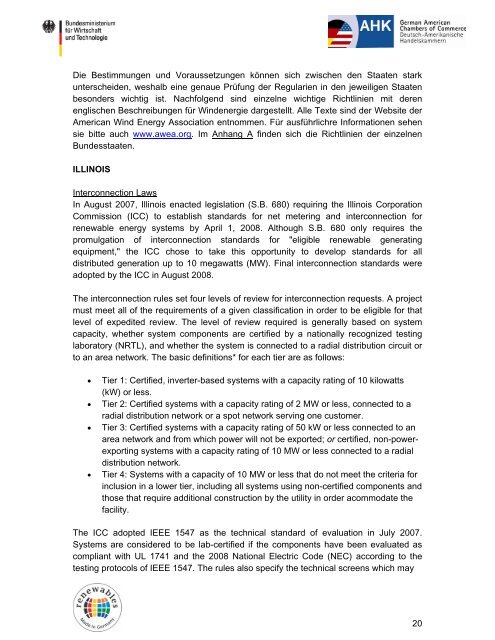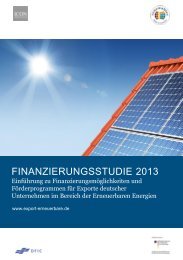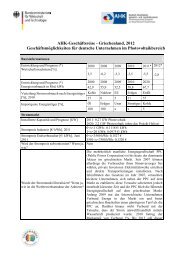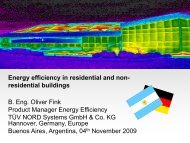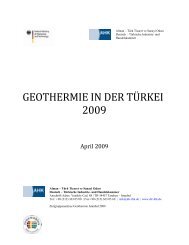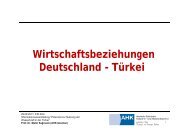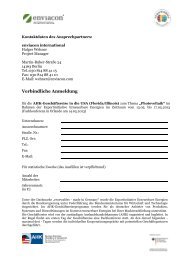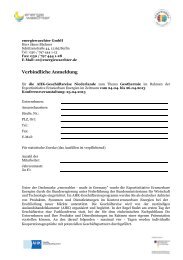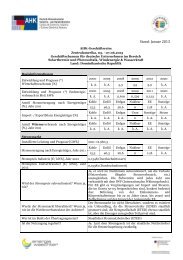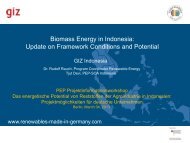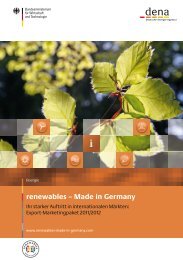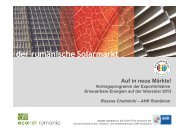PDF: 1,1 MB - Exportinitiative Erneuerbare Energien
PDF: 1,1 MB - Exportinitiative Erneuerbare Energien
PDF: 1,1 MB - Exportinitiative Erneuerbare Energien
- No tags were found...
Create successful ePaper yourself
Turn your PDF publications into a flip-book with our unique Google optimized e-Paper software.
Die Bestimmungen und Voraussetzungen können sich zwischen den Staaten stark<br />
unterscheiden, weshalb eine genaue Prüfung der Regularien in den jeweiligen Staaten<br />
besonders wichtig ist. Nachfolgend sind einzelne wichtige Richtlinien mit deren<br />
englischen Beschreibungen für Windenergie dargestellt. Alle Texte sind der Website der<br />
American Wind Energy Association entnommen. Für ausführlichre Informationen sehen<br />
sie bitte auch www.awea.org. Im Anhang A finden sich die Richtlinien der einzelnen<br />
Bundesstaaten.<br />
ILLINOIS<br />
Interconnection Laws<br />
In August 2007, Illinois enacted legislation (S.B. 680) requiring the Illinois Corporation<br />
Commission (ICC) to establish standards for net metering and interconnection for<br />
renewable energy systems by April 1, 2008. Although S.B. 680 only requires the<br />
promulgation of interconnection standards for "eligible renewable generating<br />
equipment," the ICC chose to take this opportunity to develop standards for all<br />
distributed generation up to 10 megawatts (MW). Final interconnection standards were<br />
adopted by the ICC in August 2008.<br />
The interconnection rules set four levels of review for interconnection requests. A project<br />
must meet all of the requirements of a given classification in order to be eligible for that<br />
level of expedited review. The level of review required is generally based on system<br />
capacity, whether system components are certified by a nationally recognized testing<br />
laboratory (NRTL), and whether the system is connected to a radial distribution circuit or<br />
to an area network. The basic definitions* for each tier are as follows:<br />
Tier 1: Certified, inverter-based systems with a capacity rating of 10 kilowatts<br />
(kW) or less.<br />
Tier 2: Certified systems with a capacity rating of 2 MW or less, connected to a<br />
radial distribution network or a spot network serving one customer.<br />
Tier 3: Certified systems with a capacity rating of 50 kW or less connected to an<br />
area network and from which power will not be exported; or certified, non-powerexporting<br />
systems with a capacity rating of 10 MW or less connected to a radial<br />
distribution network.<br />
Tier 4: Systems with a capacity of 10 MW or less that do not meet the criteria for<br />
inclusion in a lower tier, including all systems using non-certified components and<br />
those that require additional construction by the utility in order acommodate the<br />
facility.<br />
The ICC adopted IEEE 1547 as the technical standard of evaluation in July 2007.<br />
Systems are considered to be lab-certified if the components have been evaluated as<br />
compliant with UL 1741 and the 2008 National Electric Code (NEC) according to the<br />
testing protocols of IEEE 1547. The rules also specify the technical screens which may<br />
20


